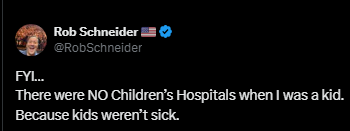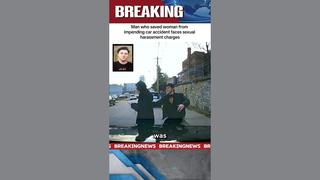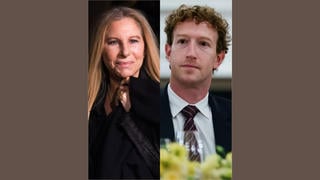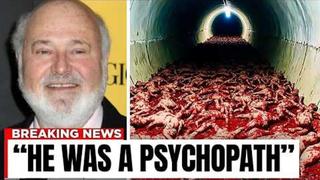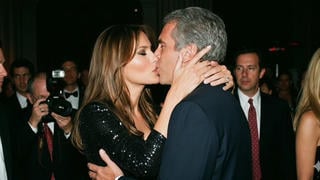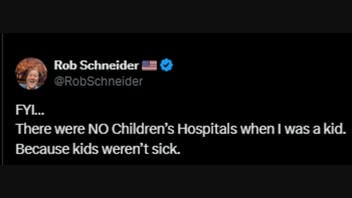
Did the United States have no children's hospitals in the 1960s and 1970s, when comedian Rob Schneider was a child? No, that's not true: The first children's hospital was opened in Philadelphia in 1855, with 26 operating by 1895, according to an academic paper. Hospitals opened in the 1960s include St. Jude Children's Research Hospital in Memphis.
The claim originated in a post (archived here) published by Rob Schneider on X on October 22, 2025. It read:
FYI...
There were NO Children's Hospitals when I was a kid.
Because kids weren't sick.
This is what the post looked like at the time of writing:
(Image source: Lead Stories screenshot of X.com)
Schneider, a comedic actor, has been an outspoken critic of American healthcare -- specifically mandated childhood vaccinations -- for several years. His social media posts and his public performances often include messages about his belief that vaccinations are to blame for many childhood illnesses. It is unclear if he was serious about the claim that there were no hospitals when he was a child, which would have been from about 1963 to about 1980. Lead Stories was unable to reach Schneider to ask him, but someone close to him (who spoke on condition of anonymity) said it looked like a joke since he was "totally aware of children's hospitals as he was a big volunteer as a kid for the Jerry Lewis Muscular Dystrophy Association Telethon."
If it was a joke, the premise of it is still false. A paper titled "A history of Academic Medical Centers and Children's Hospital designations in the United States" (archived here), published by the Journal of Pediatrics, said that there are 113 hospitals in the U.S. registered as children's hospitals and that "49 are freestanding and 64 are 'children's hospitals within hospitals.'" While the Hôpital des Enfants Malades in Paris opened for sick children in 1815, the first U.S. children's hospital came 40 years later:
In the United States, the designation of the first children's hospital is variously attributed to either the Children's Hospital of Philadelphia in 1855 or the New York Nursery and Child's Hospital (later merging with Babies Hospital) in 1854. Socially conscious citizens joined with physicians to create these early hospitals, predominantly charitable institutions for poor orphans.
The number of hospitals and sections of hospitals in the U.S. continued to grow over the next decades:
The popularity of these hospitals led to their establishment in most major cities, such that by 1895 there were 26 freestanding children's hospitals in the United States. Appointment to the medical staff of such an institution also conferred an elevated social status to the appointee. Toward the late 1800s, in addition to these hospitals specifically for children, many municipal hospitals added children's wards of their own. By 1900, inpatient pediatric facilities were common in most urban hospitals. A survey of American medical colleges at the turn of the nineteenth century found that fully 55% (64/117) had at least 1 faculty member specializing in pediatric medicine and on staff. By the 1930s, academic centers had either affiliated with or owned their own hospitals and were developing into roughly the shape and scope of modern institutions today, many using the concept of a children's hospital within the outer walls of a larger hospital.
St. Jude Children's Research Hospital, which was funded through entertainer Danny Thomas's efforts, was opened in Memphis in 1962, a year before Schneider's birth.

